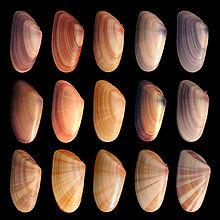- Donax
-
- For the Marantaceae genus, see Donax (plant).
Donax 
Donax variabilis Scientific classification Kingdom: Animalia Phylum: Mollusca Class: Bivalvia Order: Veneroida Family: Donacidae Genus: Donax
Linnaeus, 1758Species See text.
Donax is a genus of small, edible saltwater clams, marine bivalve mollusks. The genus is sometimes known as bean clams; however, Donax species have various common names in different parts of the world.
Species of Donax live, sometimes in high concentrations, vertically aligned in the sand on exposed beaches, on tropical and temperate coasts worldwide. When the waves wash these small clams out of the sand, they can dig back in again quite rapidly. They are filter feeders. Some species, such as Donax variabilis, migrate vertically and horizontally with changes in the tides.
Species
Species within the genus Donax include:
- Donax carinatus
- Donax cuneatus
- Donax denticulatus
- Donax dentifer
- Donax faba
- Donax fossor - Used to be thought to be simply a northern form of D. variabilis, but it now seems to be the case that the Donax found in the most northerly part of the range, including the outer shores of Long Island, New York, is in fact not a paler northern version of D. variabilis, but a different species, D. fossor.
- Donax gouldii - The bean clam
- Donax hanleyanus
- Donax madagascariensis
- Donax oweni
- Donax pallidus
- Donax peruvianus
- Donax punctatostriatus
- Donax trunculus - Locally known as tellin, tellina or telline in French and coquina in Spanish.
- Donax variabilis - Known in Florida under the Spanish word "coquina", is the common and colorful Donax species of the southern Atlantic and Gulf shores from Virginia to the Caribbean. This species is locally abundant on beaches with fine sand from the mid-Atlantic coast to Texas, and likely beyond. If found open they are sometimes referred to as "butterfly shells".[citation needed]
- Donax variegatus
- Donax venustusus
- Donax vittatus
The empty small (15 to 25 mm) shells of Donax variabilis and Donax fossor may be found washed up on the beach, especially at low tide. The living animals can often be seen where the waves wash the sand around in the most shallow part of the littoral zone as the tidal level changes. These clams can use the action of waves to move themselves up and down the beach, quickly burrowing into a new location before they can be swept away (the so-called "dance of the coquina").
References
Further reading
- The Nautilus, On the species of Donax of Eastern North America , March 1892, pp. 125-126
- Wayne A. O'Connor & Stephan J. O’Connor, Early ontogeny of the pipi, Donax (Plebidonax) deltoides (Donacidae; Bivalvia); Molluscan Research 31(1): 53–56; ISSN 1323-5818

This bivalve-related article is a stub. You can help Wikipedia by expanding it.
